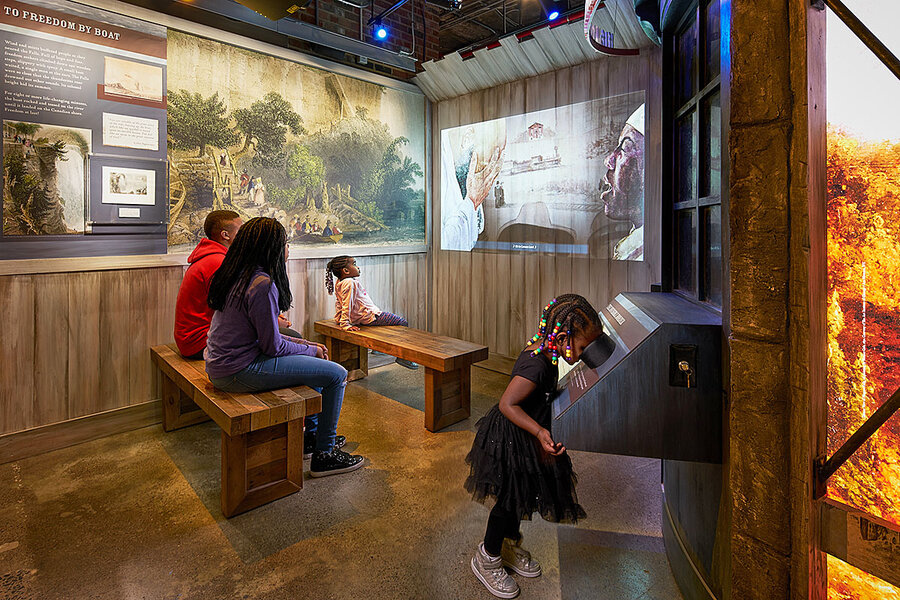At Canadian end of Underground Railroad, issues not all black and white
Loading...
| Niagara Falls, N.Y.
Deirdre Reynolds guides a group of 12- and 13-year-old boys from Buffalo to a recreated suspension bridge that once spanned the Niagara River.
“What does that say?” she asks before they cross in a single file. “Freedom, Canada. Slavery, United States.”
One boy asks if he should run. “We are not going to run anywhere here, because it’s a museum,” she responds.
Why We Wrote This
Canada has long been a haven for those in the United States seeking to avoid authorities' reach. But Canada's role as host is more complex – and sometimes less welcoming – than its reputation would have it.
But the boy is right to ask: They are in the Niagara Falls Underground Railroad Heritage Center, an experiential space that allows visitors to retrace the steps of enslaved black Americans fleeing the United States for their life to Canada.
They regroup at a window that looks across the international border – a Canadian flag fluttering across the gorge – where American abolitionist Harriet Tubman herself crossed. The history lesson is fully focused on the thousands of “freedom seekers” and black abolitionists who aided their escape, especially in the years leading up to the American Civil War. It’s particularly important this month: August 23 is the International Day for the Remembrance of the Slave Trade and its Abolition.
But the group is also treading a centuries-long path to Canada that continues to the present, with thousands of asylum seekers crossing the northern border. And Ally Spongr, the center’s director and curator, says their aim is to connect the past to the present to inspire visitors to contemplate the reasons behind the need to escape, the complicated reality of welcome, and the morality of the roles that the players assume.
“Who is a freedom seeker today?’ she says. Too many don’t take the time to consider it.
Even at this border, Americans may be well versed in what happens at the Mexican border, she says, without realizing that foreigners are also crossing here to leave the US. The number of asylum seekers intercepted at unofficial points of entry into Canada – to avoid being sent back to the US under an agreement between the two nations – spiked last year. But they continue to arrive. By the end of July, 12,378 had been intercepted by the Royal Canadian Mounted Police, the vast majority at Quebec’s frontier with New York.
“Some are saying, ‘I’m afraid. I need to leave the US,’ ” says Ms. Spongr, whose center opened in May and is connected to a train station that shares space, perhaps fittingly for the experience, with United States Customs and Border Protection. “And I think it’s a powerful and really important thing to think about, and the public to realize.”
Canada has served as a refuge for Americans since the founding of the US, when colonists loyal to the British Crown fled before and after the American Revolution. In the 1960s and ’70s, those opposed to the Vietnam War and the draft found a haven in Canada. When President Trump won the 2016 presidential election, liberal Americans lit up social media with ideas about emigrating north.
That’s often allowed Canada to take the moral high ground against American politics, from the underground railroad to today’s refugee policies.
“The idea of the underground railroad, and being the terminus of the underground railroad, was quite popular,” says Karolyn Smardz Frost, a Canadian historian and author of “Steal Away Home,” about an enslaved woman’s escape north and return home. “It was one-upping the Americans to some extent. We still do it. We are the people with the open-door policy with blankets around refugees as opposed to putting them in handcuffs.”
She says the reality, of course, is far more complicated.
Most of the help that “freedom seekers” received came not from the government, but from those in the Canadian community of black immigrants, many of whom had escaped slavery, and life was hard. After the Fugitive Slave Act was put into place in 1850, support for the abolitionist movement waned in some corners, giving way to fears of a massive migration of black refugees from the US. Not unlike today, many helped, while others resented the smuggling in of “freedom seekers” to escape American policy.
Jodi Giesbrecht, the manager of research and curation at the Canadian Museum for Human Rights in Winnipeg, Manitoba, says Canada’s role in the underground railroad has often tended toward romanticism. “I don’t think people necessarily understand the depth of racism and discrimination that existed here and that escaped slaves continued to face,” she says.
Their exhibit on it, part of the Canadian Journeys gallery, attempts to challenge people’s assumptions about Canada. “I think it’s important not to depict either the history of people coming to Canada or the present in overly simplistic terms,” she says. “When we see Canada as unquestionably welcoming, we fail to see the hardships and discrimination a lot of people really face. And everyone has a role to play in making Canada a more equitable society.”
That is what Ms. Reynolds seeks to teach her school-age group on a recent day. After learning of a slaver who offers cash to help arrest an escaped woman in Niagara Falls named Martha in 1853, she asks the boys if they would take the money, the equivalent today of $3,000. None says he would.
“But people did. And even more people just watched all this happen,” she says, imparting a lesson that applies just as much today as in the 19th century. “People think you were either for slavery or you were against it. But a lot of people just didn’t do anything at all.”







